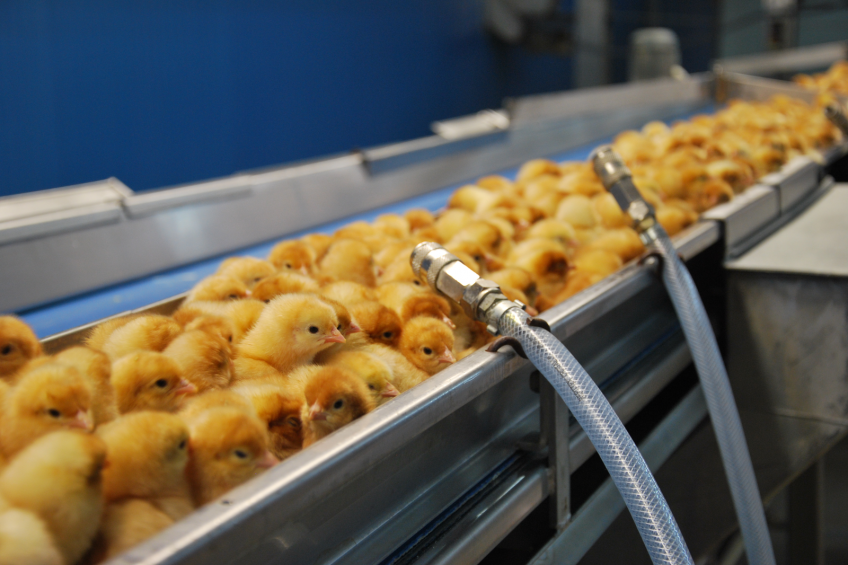IB, ND and MPV vaccination in one go

Individual vaccine administration to day old chicks is common practice. But joint administration of respiratory vaccines against Newcastle disease, Infectious Bronchitis and Pneumovirus, might be timesaving. Field experiments indicate that this seems possible.
By J.S. Corella, J. Rubio, J. Villa and H. Fathi, Hipra, Spain
The need to reduce the number of days of vaccination in broiler flocks, has led to studies for defining the possible joint administration of a vaccine for preventing avian Metapneumovirus with other types of respiratory vaccines. Up to now, these vaccines have been administered separately in order to minimise interaction between them. In principle, the fact that they all compete for the same receptors, would imply that there would be interaction between them and, in the end, the protection afforded against pneumovirus could be affected.
However, from Hipra tests it was discovered that there is no sufficient interaction to impair the safety and efficacy of these vaccines when jointly administered. To do so, the presence of respiratory reactions after vaccination, as well as the efficacy by observing clinical signs after challenge, were evaluated.
Three vaccines
For the study, three vaccines were used:
- Hipraviar SHS: live vaccine against Pneumovirus
- Hipraviar CLON: live vaccine against Newcastle disease
- Hipraviar CLON/H120: live vaccine against Newcastle disease and Infectious Bronchitis
A total of 100 commercial broilers from a hatchery with health control were used. The chicks came from breeder flocks, vaccinated against the three diseases. After applying the various vaccines, the birds were housed in four different isolation units. Immunisation groups were as follows: (A) 10 broilers, (B) 20 broilers, (C) 30 broilers and (D) 40 broilers (see Table 1).
The vaccines were reconstituted following the manufacturer’s instructions. Each vial was reconstituted in a 30-ml dropper with sterile solution. In the case of joint administration, two or three vials were reconstituted in the same dropper and administered by ocular route. The vaccination programmes were applied to the different groups at one day of age.
The challenge took place 21 days after vaccination. In order to do so, four challenge groups were designed that, for reasons of availability of isolation units, had to be housed together for each challenge virus (Table 2).
The challenge strains used against avian pneumovirus were virulent subtype B administered at a rate of 0.2 ml per chick by oral route. The Newcastle disease challenge was the Herts strain administered at a rate of 0.2 ml per chick by intramuscular route. And the Bronchitis challenge was the M41 strain at a rate of 0.2 ml per chick by ocular route.
Safety assessment
After vaccination, the birds were observed daily for 10 consecutive days to determine the presence of clinical signs attributable to the joint administration of the vaccines.
The following evaluation criteria were used to assess the presence of vaccine reactions:
- Presence of mild clinical signs (watery eyes).
- Presence of moderate clinical signs (respiratory symptomatology with coughing, panting, etc.).
- Presence of severe clinical signs (severe respiratory symptomatology and depression).
Very mild clinical signs were observed in only one bird, but no significant differences between the groups vaccinated with the various vaccine programmes and the non-vaccinated group. Hence, it can be concluded that joint administration of various vaccine viruses does not increase respiratory type reactions.
Efficacy assessment
After each challenge, the birds of each group were observed for 10 consecutive days to determine mortality and assess the presence of clinical signs. From the challenge with avian Metapneumovirus, the following stages were used:
- Little nasal discharge
- Moderate nasal discharge
- Abundant nasal discharge
- Turbid nasal discharge
- Ocular discharge
- Swollen sinus
- Mortality
The vaccinated groups showed little symptomatology, whereas various levels of nasal discharge oscillating from level 1 to 3 was observed in the control group. Mortality was not recorded in any case.
In the case of Newcastle disease, mortality after the challenge was observed. It turned out that the two vaccinated groups were protected against the challenge, whereas 80% mortality was observed in the non-vaccinated group.
Assessment against IB
The presence of clinical signs and ciliastatic activity in the trachea after the challenge were assessed, using the following criteria:
- Presence of mild clinical signs (watery eyes)
- Presence of moderate clinical signs (respiratory symptomatology with coughing, panting, etc.)
- Presence of severe clinical signs (severe respiratory symptomatology and depression)
The challenge group showed a higher incidence of clinical signs than the control group.
Five assessment criteria were used to evaluate ciliastatic activity in the trachea:
0: All cilia showed activity
1: 75% showed activity
2: 50% showed activity
3: 25 % showed activity
4: None showed activity
It was found that differences in ciliastatic activity were not as pronounced between the vaccinated group (three live vaccines) and the challenged group. It turns out that the evaluation of efficacy by measuring ciliastatic activity may not be adequate for the situation.
Joint vaccination possible
The experiment made clear that vaccinated birds showed no obvious clinical signs attributable to joint vaccination. This indicates that combined vaccination with different products did not produce any post-vaccination reactions under the experimental conditions.
This study provides a first approach to the safety and efficacy of the combination of respiratory vaccines. It must be noted that this is an experimental study and environmental and epidemiological parameters were controlled.













